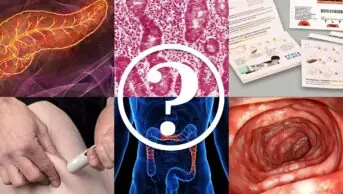
Shutterstock.com
After reading this article, you should:
- Know the symptoms associated with pancreatic exocrine insufficiency (PEI);
- Identify the patient groups at risk of developing PEI;
- Understand how PEI is managed using pancreatic enzyme replacement therapy;
- Understand the role of pharmacists in the management of PEI.
Introduction
Pancreatic exocrine insufficiency (PEI) occurs when the pancreas is unable to produce sufficient enzymes to aid digestion1. As a result, patients may become malnourished owing to inadequate absorption of nutrients2. In people with pancreatic illnesses, the incidence of PEI varies depending on the underlying cause. Globally, chronic pancreatitis is the most common cause of PEI, with 80–90% of patients experiencing symptoms3. In patients with pancreatic cancers, 66–92% experience PEI4.
National Institute for Health and Care Excellence (NICE) guidance for the management of PEI in pancreatitis, published in 2018, recommends monitoring patients for symptoms of malabsorption and malnutrition — such as loose stools and weight loss — and ensuring that patients are referred to dietitians to determine if pancreatic enzyme replacement therapy (PERT) is required5.
In pancreatic cancers, NICE guidance, published in 2018, recommends that all patients with unresectable pancreatic cancers should be initiated on PERT, while those with resectable cancers should be reviewed before and after resection to determine if PERT is required6.
Pharmacists have a role in the review and management of patients with PEI. It is, therefore, important that they are able to recognise the presenting symptoms and understand how PEI can be managed using PERT. When reviewing patients taking PERT, recognition of symptoms of PEI may help to identify suboptimal dosing and provide an opportunity to optimise management. When patients are newly initiated on PERT, pharmacists play a crucial role in providing education on the correct use of PERT, including advising patients on ongoing PERT shortages7.
Overview of normal pancreas function and the pathophysiology of PEI
The pancreas is a glandular organ with a dual function (see Figure)8,9.
Any disease that destroys pancreatic tissue or blocks the ducts within the pancreas can cause PEI (see causes below). In cases of impaired pancreatic function, patients may present with endocrine insufficiency — which is characterised by a reduction in functional islet cell mass and reduced insulin secretion — and subsequently results in impairments of glucose tolerance10,11. Patients may also present with exocrine insufficiency owing to inadequate production of pancreatic enzymes to aid digestion1.
Causes
Conditions that result in the loss of functional pancreatic parenchyma can cause disruptions to normal pancreatic exocrine function12. Causes of PEI include inflammatory conditions of the pancreas — for example:
- Acute pancreatitis: an acute inflammatory response resulting from injury to the pancreas13;
- Chronic pancreatitis: pancreatic inflammation owing to repeated episodes of acute pancreatitis, resulting in irreversible damage to the pancreas14.
The development of pancreatitis may stem from gallstones, excessive alcohol intake, hereditary factors or autoimmune conditions5.
Malignant or premalignant conditions may also cause PEI. Healthcare professionals should evaluate symptoms and consider whether PERT is appropriate for patients with the following pathologies:
- Pancreatic cancer;
- Intraductal papillary mucinous neoplasm;
- Ampullary cancer;
- Duodenal cancer;
- Cholangiocarcinoma;
- Pancreatic neuroendocrine tumours15.
Signs and symptoms
Patients with PEI commonly present to primary and secondary care with the symptoms shown in Table 116–21.
Patients presenting with jaundice, unintentional weight loss or ongoing symptoms of PEI with no known underlying pancreatic illnesses should be urgently referred for further investigations to rule out pancreatic malignancy22.
Diagnosis
Owing to the range of symptoms associated with PEI (as seen in Table 1), patients may present to community pharmacies, GP surgeries or A&E. If presenting to community pharmacy, patients should be referred to their GP for further review.
PEI is diagnosed by the presence of chronic diarrhoea/steatorrhea (i.e. excessive fat in the stool) and abdominal pain in conjunction with identified risk factors, such as pancreatic disorders, alcohol excess, diabetes, weight loss, malaise and suspicion of malignancy23.
If the diagnosis is unclear, additional tests can be carried out to confirm PEI. As per the ‘Consensus for the management of pancreatic exocrine insufficiency UK practical guidelines’, published in 2021, FEL-1 testing is recommended2. FEL-1 testing is a marker of pancreatic secretion of enzymes and is valuable in supporting a diagnosis of PEI in the presence of symptoms of malabsorption and malnutrition (see Table 1)2. FEL-1 testing is non-invasive and is undertaken using a small amount of faeces2. If samples are contaminated by water, false-positive results may occur. Therefore, stools classified as type 7 on the Bristol stool chart should not be used2.
When reviewing FEL-1 results, the following ranges can be used to identify the severity of PEI24.
As FEL-1 only tests for human elastase, administration of PERT does not have an effect on results, as PERT products are of porcine origin2,25–31.
In the following conditions, the likelihood of developing PEI is high. Therefore, patients are likely to benefit from PERT2. In these patient groups, FEL-1 testing is not required as negative predictive values of FEL-1 do not prevent treatment initiation2:
- Pancreatic cancer;
- Total pancreatectomy;
- Symptomatic chronic pancreatitis;
- Severe necrotising pancreatitis.
In patients with symptoms of PEI without known associated conditions, FEL-1 testing should be carried out alongside cross-sectional imaging to exclude obstructive tumours2. If a pancreatic cause has not been identified, FEL-1 tests should be repeated2.
Pancreatic enzyme replacement therapy
There are several forms of PERT available, with each preparation containing different quantities of pancreatic enzymes. Therefore, these products are not directly interchangeable 25–31.
When initiating treatment, the recommended dose of PERT is 50,000 units of lipase per meal and 25,000 units of lipase per snack32. Following the initiation of PERT, patients should be reviewed after four to six weeks to determine if symptom control has been achieved23.
When symptom control is achieved, patients with pancreatic cancer should receive ongoing monitoring for symptoms of PEI every four to six weeks23. In those patients with other pancreatic conditions, six-monthly monitoring is recommended23. If symptom control is not achieved, patients should be referred to a dietitian, and doses should be titrated according to the level of response23,32. When correct dosing is achieved, symptoms of PEI should be normalised32.
PERT shortage
Current supply issues with PERT may result in patients experiencing difficulties or delays in obtaining this medicine36. As supply issues are predicted to continue until 2026, patients may need to be switched to alternative PERT products, and additional symptomatic management may need to be implemented36. More information about the PERT shortage can be found here.
A joint position statement, published in 2024, regarding the clinical management of this shortage in adult patients suggests:
- Consider prescribing a proton pump inhibitor/H2 receptor antagonists to reduce acid degradation and improve PERT efficacy;
- Consider prescribing loperamide to reduce faecal urgency and diarrhoea, where infective or obstructive causes have been ruled out;
- Consider prescribing Buscopan (hyoscine butylbromide; Sanofi) for abdominal discomfort;
- Consider multivitamin and mineral replacement and calcium and vitamin D supplementation for patients not already taking these medicines36.
As PERT is essential for maintaining control of PEI symptoms, clinicians should be mindful that supply issues may result in anxiety and concern for patients. Patients should be reviewed on a case-by-case basis, and where patients are reporting weight loss or unmanageable symptoms owing to an inability to obtain PERT, further advice should be sought from local dietetics teams36. Additional information can be found in: ‘How to navigate and ensure effective patient communication about medicines shortages’.
As each PERT is not directly interchangeable, when patients need to be switched to alternative products, the conversions shown in Table 4 can be used.
Patient counselling
When administering PERT, patients should be provided with the following information:
- PERT should be taken with all meals and snacks containing fat and drinks containing >50% of milk;
- Half of the PERT dose should be taken at the start of the meal, with the other half being spread throughout the remainder of the meal;
- PERT should be swallowed whole and should not be chewed or crushed, as this may reduce enzyme effectiveness and cause oromucosal irritation;
- If a drink is needed to assist with swallowing, hot drinks should be avoided as they may reduce enzyme effectiveness33.
In patients with swallowing difficulties:
- Capsules can be opened, and the enzymes should be administered in a spoonful of soft acidic food, such as jam or fruit puree — this is because pH >5.5 may disrupt the coating on the granules inside the capsules and reduce efficacy;
- Once opened, the capsule contents should be taken immediately;
- The capsule contents should be washed down with a cold drink to ensure that granules do not remain in the mouth, as this may cause oromucosal irritation33,34.
On the initiation of PERT, patients should be made aware of common side effects, including abdominal distension, constipation, nausea and vomiting35. If experiencing adverse effects, patients should report this to a healthcare professional. In the case of serious adverse effects, such as hypersensitivity reactions, patients should discontinue PERT and seek further guidance from the prescribing clinician.
Patients should understand that it may take several days for PERT to be effective, and it is beneficial to keep a food diary to help monitor symptoms and guide dose adjustments33. Patients should understand that dietary fat restriction is not routinely recommended, as this may exacerbate malnutrition2.
As nutrient deficiencies are common, all patients on PERT should have vitamin and micronutrient screening on initiation and at regular intervals (six months if deficiency detected and annually thereafter)23.
Case study
A 60-year-old female presented to A&E with central, epigastric pain, which was accompanied by nausea and two episodes of vomiting within a 24-hour period. Her past medical history included hypertension and two previous hospital admissions for acute pancreatitis.
The patient’s medication history included amlodipine 5mg once daily and loperamide 2mg up to four times per day as required, which were purchased over the counter. Once questioned about the indication for loperamide, the patient reported ongoing loose stools, which was accompanied by epigastric pain and unintentional weight loss of 5kg.
On review of her social history, the patient reported that she was a non-smoker and drinks ~15–20 units of alcohol on weekends. Following her previous admission for acute pancreatitis, she was abstinent from alcohol for three months but states that she restarted drinking within a social setting.
Upon completing the medication history, the pharmacist identified symptoms of PEI associated with a history of acute pancreatitis, as well as unintentional weight loss. The pharmacist then highlighted this to the medical team for further review.
Following this, the patient had a blood test which showed normal urea and electrolytes and liver function tests. Owing to ongoing diarrhoea symptoms, FEL-1 testing was undertaken, which was reported as 80 µg/g stool. The patient also had an abdominal CT, which showed evidence of acute pancreatitis and evidence of established chronic pancreatitis.
The presence of chronic pancreatitis, unintentional weight loss, loose stools and an FEL-1 result of 80 µg/g indicated severe PEI, requiring treatment with PERT.
Initially, the patient was prescribed 50,000 units of lipase with meals and 25,000 units of lipase with snacks. As this was a new medicine, the pharmacist provided counselling regarding the indication for PERT, as well as advice regarding the administration and common side effects associated with treatment.
To manage expectations of treatment, the pharmacist highlighted that it may take several days for PERT to be effective and advised keeping a food diary to help monitor symptoms. As alcohol is a causative factor for chronic pancreatitis, the pharmacist provided advice regarding abstinence from alcohol to avoid future pancreatitis flare-ups.
During the inpatient admission, the patient was referred to a dietitian for further review of PEI symptoms, and a vitamin and mineral screen was undertaken to test for deficiencies. To ensure ongoing review, the patient was referred to community dietitians on discharge for monitoring of PEI symptoms and optimisation of PERT dosing. She was also referred to her local hepatobiliary and pancreatic team for ongoing review.
Best practice points
- Untreated PEI may result in malabsorption and malnutrition. Recognition of the causes and symptoms is important to ensure prompt initiation of PERT;
- Ongoing review of PEI symptoms is essential to optimise PERT dosing. When correct dosing is achieved, symptoms of PEI should be controlled;
- Patients requiring PERT should be counselled regarding administration and side effects on initiation;
- On the initiation of PERT, vitamin and micronutrient screening should be undertaken;
- Owing to PERT shortages, PERT preparations may need to be switched to ensure ongoing supply;
- Ongoing weight loss and unmanageable symptoms require referral to a dietitian;
- Absorption of other medicines may be affected in patients with malabsorptive diarrhoea resulting from PEI.
- This article was amended on 8 May 2025 to update a reference and correct an error in Table 3
- 1.What is PEI? ThinkPEI. 2019. https://www.thinkpei.com/en-gb/understanding-pei/what-is-pei
- 2.Phillips ME, Hopper AD, Leeds JS, et al. Consensus for the management of pancreatic exocrine insufficiency: UK practical guidelines. BMJ Open Gastroenterol. 2021;8(1):e000643. doi:10.1136/bmjgast-2021-000643
- 3.Chronic Pancreatitis. Creon. 2023. https://www.creon.co.uk/en-gb/hcp/efficacy-and-tolerability/chronic-pancreatitis#
- 4.Pancreatic Cancer. ThinkPEI. 2019. https://www.thinkpei.com/en-gb/pei-and-associated-ta/pancreatic-cancer
- 5.Pancreatitis – Guidance NG104. National Institute for Health and Care Excellence. 2018. https://www.nice.org.uk/guidance/ng104/chapter/Recommendations#chronic-pancreatitis
- 6.Pancreatic cancer in adults: diagnosis and management. National Institute for Health and Care Excellence. 2018. https://www.nice.org.uk/guidance/ng85/chapter/recommendations#nutritional-management
- 7.Garcia MAG, Imam S, Braun UK, Jackson LK. Rational Prescribing of Pancreatic Enzymes for Patients with Pancreatic Cancer. Pharmacy. 2024;12(2):47. doi:10.3390/pharmacy12020047
- 8.Karpińska M, Czauderna M. Pancreas—Its Functions, Disorders, and Physiological Impact on the Mammals’ Organism. Front Physiol. 2022;13. doi:10.3389/fphys.2022.807632
- 9.Keller J. Human pancreatic exocrine response to nutrients in health and disease. Gut. 2005;54(suppl_6):1-28. doi:10.1136/gut.2005.065946
- 10.Paniccia A, Schulick RD. Pancreatic Physiology and Functional Assessment. Blumgart’s Surgery of the Liver, Biliary Tract and Pancreas, 2-Volume Set. Published online 2017:66-76.e3. doi:10.1016/b978-0-323-34062-5.00004-2
- 11.Malecka-Panas E, Gasiorowska A, Zlobinska A, Drzewoski J, Kropiwnicka A. Endocrine Pancreatic Function in Patients after Acute Pancreatitis. PubMed; 2002. https://pubmed.ncbi.nlm.nih.gov/12397772/
- 12.Kunovský L, Dítě P, Jabandžiev P, et al. Causes of Exocrine Pancreatic Insufficiency Other Than Chronic Pancreatitis. JCM. 2021;10(24):5779. doi:10.3390/jcm10245779
- 13.Mohy-ud-din N, Morrissey S. Pancreatitis. StatPearls Publishing; 2023. https://www.ncbi.nlm.nih.gov/books/NBK538337/
- 14.Benjamin O, Lappin S. Chronic Pancreatitis. StatPearls Publishing ; 2022. https://www.ncbi.nlm.nih.gov/books/NBK482325/
- 15.Bartel MJ, Asbun H, Stauffer J, Raimondo M. Pancreatic exocrine insufficiency in pancreatic cancer: A review of the literature. Digestive and Liver Disease. 2015;47(12):1013-1020. doi:10.1016/j.dld.2015.06.015
- 16.Pancreatic Exocrine Insufficiency. GI Society- Canadian Society of Intestinal Research. 2020. https://badgut.org/information-centre/a-z-digestive-topics/pancreatic-exocrine-insufficiency/
- 17.Symptoms & Causes for Exocrine Pancreatic Insufficiency. National Institute of Diabetes and Digestive and Kidney Diseases. 2023. https://www.niddk.nih.gov/health-information/digestive-diseases/exocrine-pancreatic-insufficiency/symptoms-causes
- 18.Eden R, Coviello J, Daley S. Vitamin K Deficiency. StatPearls Publishing ; 2023. https://www.ncbi.nlm.nih.gov/books/NBK536983/
- 19.Vitamin A deficiency. World Health Organization. 2009. https://www.who.int/data/nutrition/nlis/info/vitamin-a-deficiency
- 20.Vitamin D – Vitamins and Minerals. NHS. 2020. https://www.nhs.uk/conditions/vitamins-and-minerals/vitamin-d/
- 21.Vitamin E. National Institutes of Health. 2021. https://ods.od.nih.gov/factsheets/VitaminE-Consumer/
- 22.Pancreatitis (Chronic) and PEI. Bristol, North Somerset and South Gloucestershire Integrated Care Board. 2022. https://remedy.bnssg.icb.nhs.uk/adults/gastroenterology-and-colorectal-surgery/pancreatitis-chronic-and-pei/
- 23.Pancreatic Enzyme Replacement Therapy (PERT) in Adult Patients- Guidance for Healthcare Professionals. Kings College Hospital. 2025. http://kcgs/_layouts/15/WopiFrame2.aspx?sourcedoc=%7B48e24291-d23d-45f4-a26b-6afa31363438%7D&action=view
- 24.Pancreatic Elastase 1. Health Matters. 2019. https://healthmatters.io/understand-blood-test-results/pancreatic-elastase-1
- 25.Creon 10,000 Capsules – Summary of Product Characteristics. Electronic Medicines Compendium. 2024. https://www.medicines.org.uk/emc/product/1167/smpc#gref
- 26.Creon 25,000 Capsules – Summary of Product Characteristics. Electronic Medicines Compendium. 2024. https://www.medicines.org.uk/emc/product/1168/smpc#gref
- 27.Nutrizym 22 – Summary of Product Characteristics. Electronic Medicines Compendium. 2024. https://www.medicines.org.uk/emc/product/11883/smpc#gref
- 28.Pancrex V 125 mg hard capsules – Summary of Product Characteristics. Electronic Medicines Compendium. 2024. https://www.medicines.org.uk/emc/product/1054/smpc#gref
- 29.Pancrex V 340 mg hard capsules – Summary of Product Characteristics. Electronic Medicines Compendium. 2024. https://www.medicines.org.uk/emc/product/1055/smpc#gref
- 30.Creon Micro Pancreatin 60.12 mg Gastro-resistant Granules – Summary of Product Characteristics . Electronic Medicines Compendium. 2024. https://www.medicines.org.uk/emc/product/5564/smpc#gref
- 31.Pancrex V Powder – Summary of Product Characteristics. Electronic Medicines Compendium. 2024. https://www.medicines.org.uk/emc/product/1056/smpc#gref
- 32.Dosing and administration in adults – Pancreatic exocrine insufficiency treatment. Creon. 2023. https://www.creon.co.uk/en-gb/hcp/effective-dosing/dosing-and-administration-in-adults
- 33.Taking pancreatic enzyme replacement therapy if you have pancreatic cancer. Pancreatic Cancer UK. 2023. https://www.pancreaticcancer.org.uk/information/managing-symptoms-and-side-effects/diet-and-pancreatic-cancer/pancreatic-enzyme-replacement-therapy-pert/how-do-i-take-pancreatic-enzyme-replacement-therapy-if-i-have-pancreatic-cancer/
- 34.Pancreatin. The NEWT Guidelines. 2022. https://access.newtguidelines.com/P/Pancreatin.html
- 35.Pancreatin. British National Formulary. https://bnf.nice.org.uk/drugs/pancreatin/#side-effects
- 36.Position Statement: Pancreatic enzyme replacement therapy (PERT) shortage – advice for clinicians on the management of adults with pancreatic exocrine insufficiency. Pancreatic Society of Great Britain and Ireland. 2024. https://www.psgbi.org/static/uploads/resources/Position_Statement_Shortage_of_PERT_HealthCare_Professionals_Version_4_17th_No_yW7DIIA.pdf


